The human body can survive up to 21 days without food.
The longest anyone’s gone without sleep, however, is about 11 days.
People start hallucinating on day three! That means you’re actually seeing and possibly interacting with stuff that’s not there!
Sleep is so important and so often neglected. It’s vital for our mental wellbeing and cognition. And yet, it’s often the first thing to be sacrificed when a deadline looms (cough), when we need to study for an exam, or when there’s a fun event taking place in the evening.
So, we’re oh so glad you’re here asking this important question. And I’m pleased to tell you that the answer is yes, yoga can help you sleep.
Yoga can help you fall asleep more quickly. It can also improve your sleep once you’re there by creating the physical and mental conditions for a deep slumber with fewer interruptions.
Finally, yoga’s effects on your body and mind can help you say goodnight to feelings of anxiety or stress, which, in turn, can provide you with a glorious night’s sleep.
The Science of Yoga and Sleep
Raise your hand if you’ve ever known someone to drift off to sleep during savasana.
Keep your hand up if that person was you.
I’m going to lower my hand now because I need both to type.
According to a national study performed in the US, I’m probably not alone. More than 85% of respondents said that yoga made them less stressed, and more than half reported that they slept better due to yoga.
The various components of yoga, including relaxing postures, breathing exercises, and meditation, come together to yield numerous benefits, including helping you sleep better.
Regular, consistent yoga practice can improve sleep via:
- Decreased blood pressure
- Reduced anxiety
- Fewer sleep disturbances
- Reduced sleep onset
- Better sleep quality
- Less reliance on sleep medications
What Type of Yoga Can Help You Sleep?
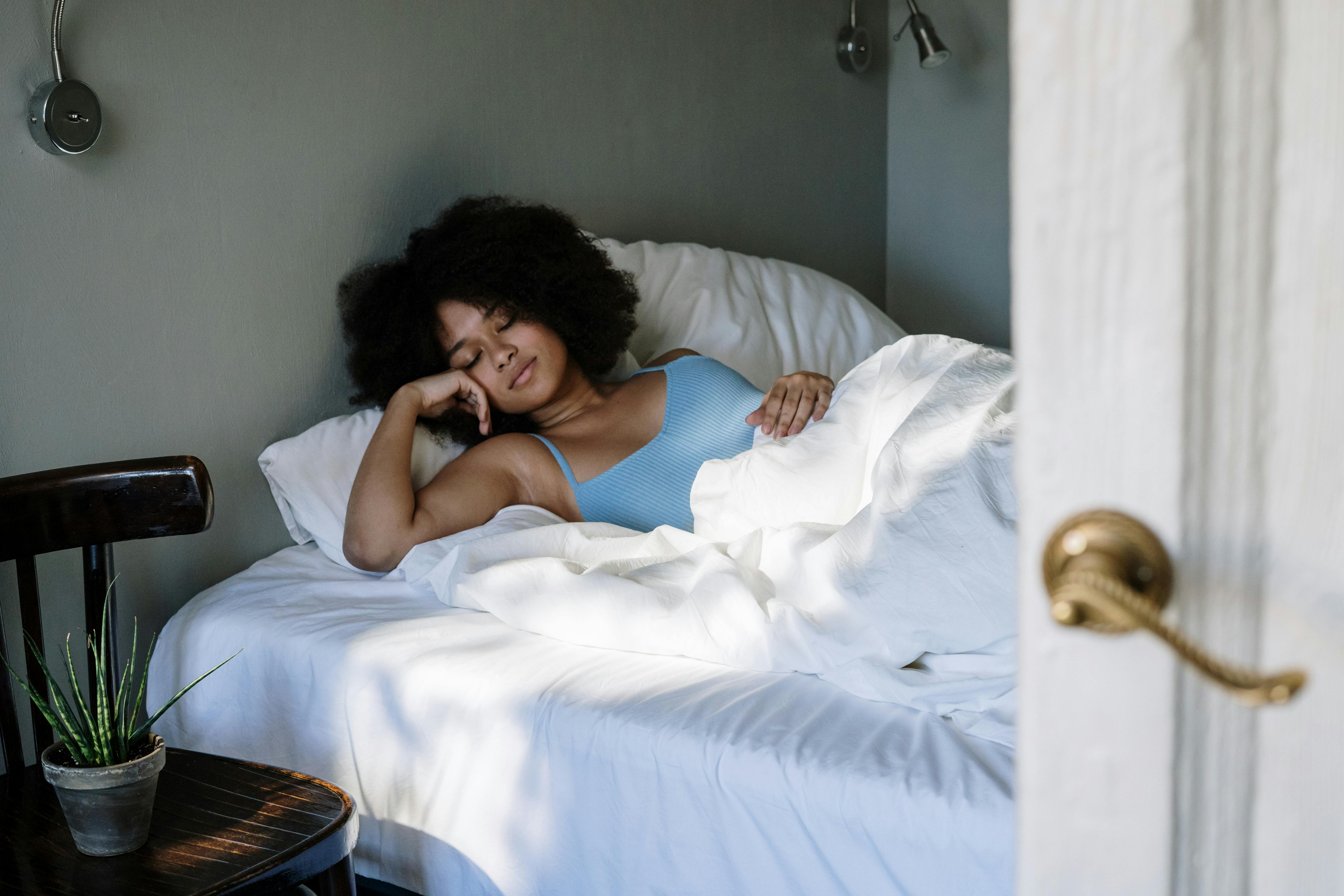
Some yoga styles are more passive while others are more active. There’s even yoga you can do in bed, so that you’re in the right place when sleep comes knocking, or gently tapping on your eyelids.
Power or vinyasa yoga that runs at a higher pace is something you can do throughout the day. It helps to tire your body so you can sleep better. However, it’s not something you might want to do near bedtime, as it can awaken your body and delay sleep onset.
Yin yoga, on the other hand, is a slow-paced style of yoga in which practitioners hold poses for several minutes. Among the benefits of this approach are introspection and relaxation. Yin yoga can create stillness that allows us to close our eyes and rest.
Because of the slow pace of yin yoga and the slow, methodical journey you take around your own body, it prepares the way for deep relaxation. It’s an exceptionally good kind of yoga to do near sleep. How near sleep? Head-on-the-pillow near.
However, as yin yoga deals with the connective tissue, it can be quite intensive for some people. Luckily, we also have restorative yoga, which is profoundly relaxing. When all else fails, restorative yoga will really help you let go.
If you like your yoga in the evening and you’re specifically looking for calming, relaxing yoga poses for sleep, look no further.
… Well, a little further.
Calming, Relaxing Yoga Poses (Asanas) for Sleep
While power yoga in the morning will boost your energy, evening yoga classes that prioritize calm will lure sleep out of hiding.
The following yoga postures are some of those ideal for releasing tension, which can lead to a good night’s sleep—or a good afternoon’s sleep, if you want to take it when you can get it.
The top sleep-inducing yoga asanas include:
Child’s Pose
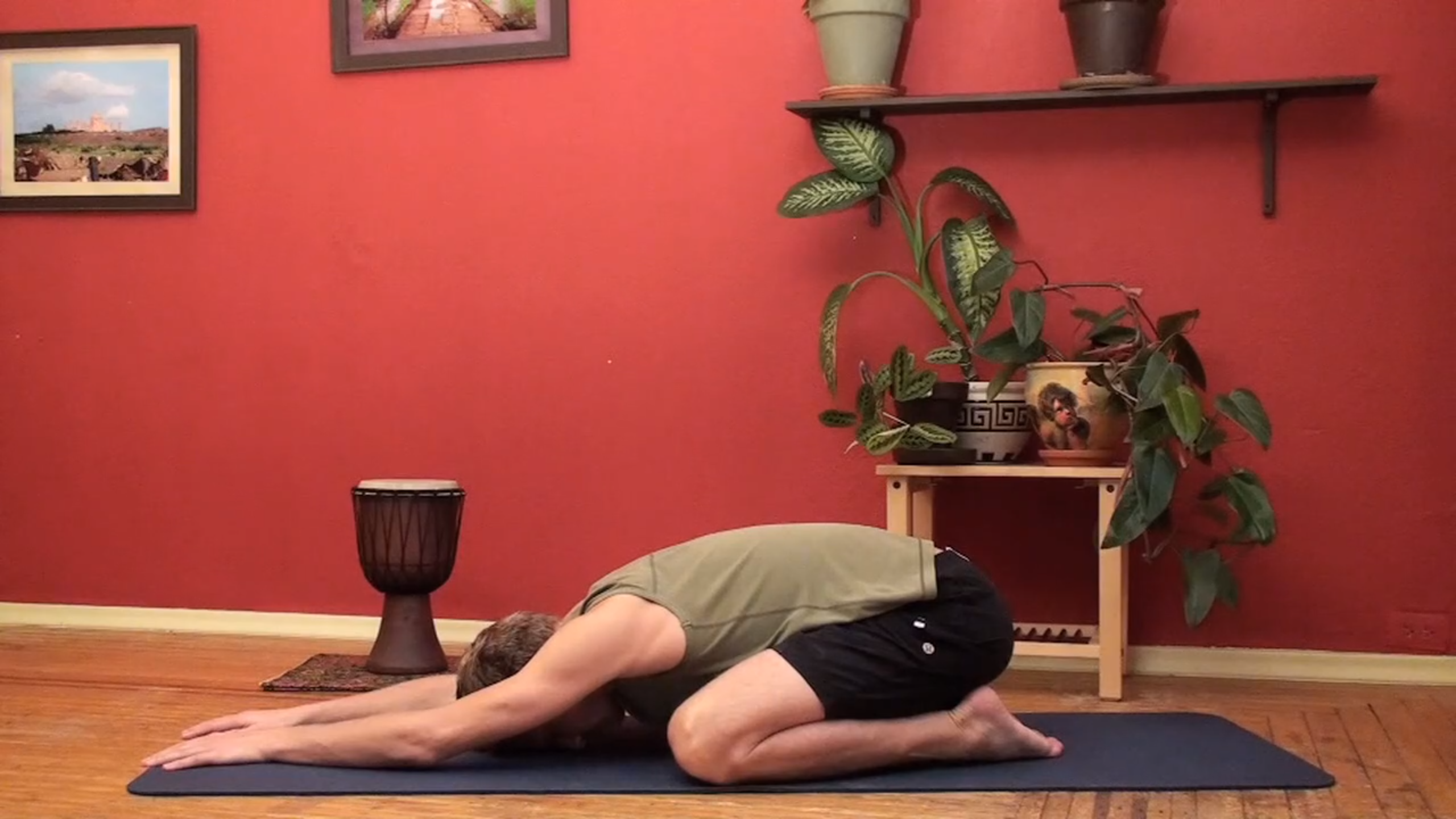
Yogis sometimes enter balasana or child’s pose during a yoga practice to rest or take a time out. It’s a grounding, comforting, restorative pose that relaxes your muscles. It’s also a good asana in which to regularize your breathing.
How to Do Child’s Pose
From all fours on your mat, spread your knees and sit back gently on your heels. Allow your forehead to rest on the mat. Breathe.
Legs Up the Wall Pose
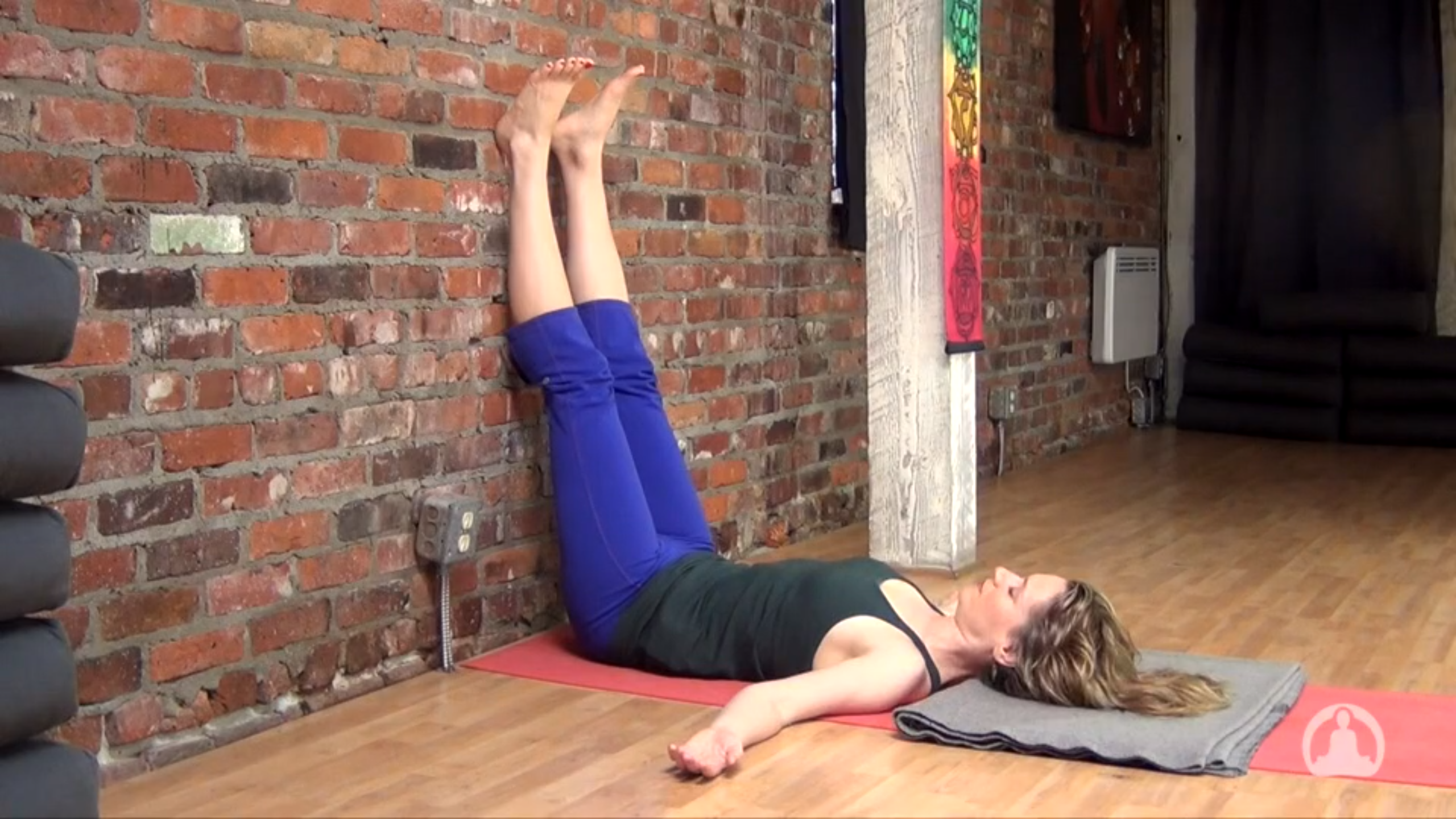
The benefits of viparita karani a.k.a. legs up the wall pose include reducing stress and tension, especially in the legs and feet. It may also provide relief from sciatica pain that’s keeping you awake, soothe headaches or migraines, improve digestion, and unwind tightness in the back.
How to Do Legs Up the Wall Pose
Set up your mat next to the wall.
Lower down on your back and swing your legs up so that they can rest against the wall.
Adjust your position by easing toward or away from the wall. Note that some people find it more comfortable to place a pillow behind their knees, especially if their hamstrings are tight.
Standing Forward Fold
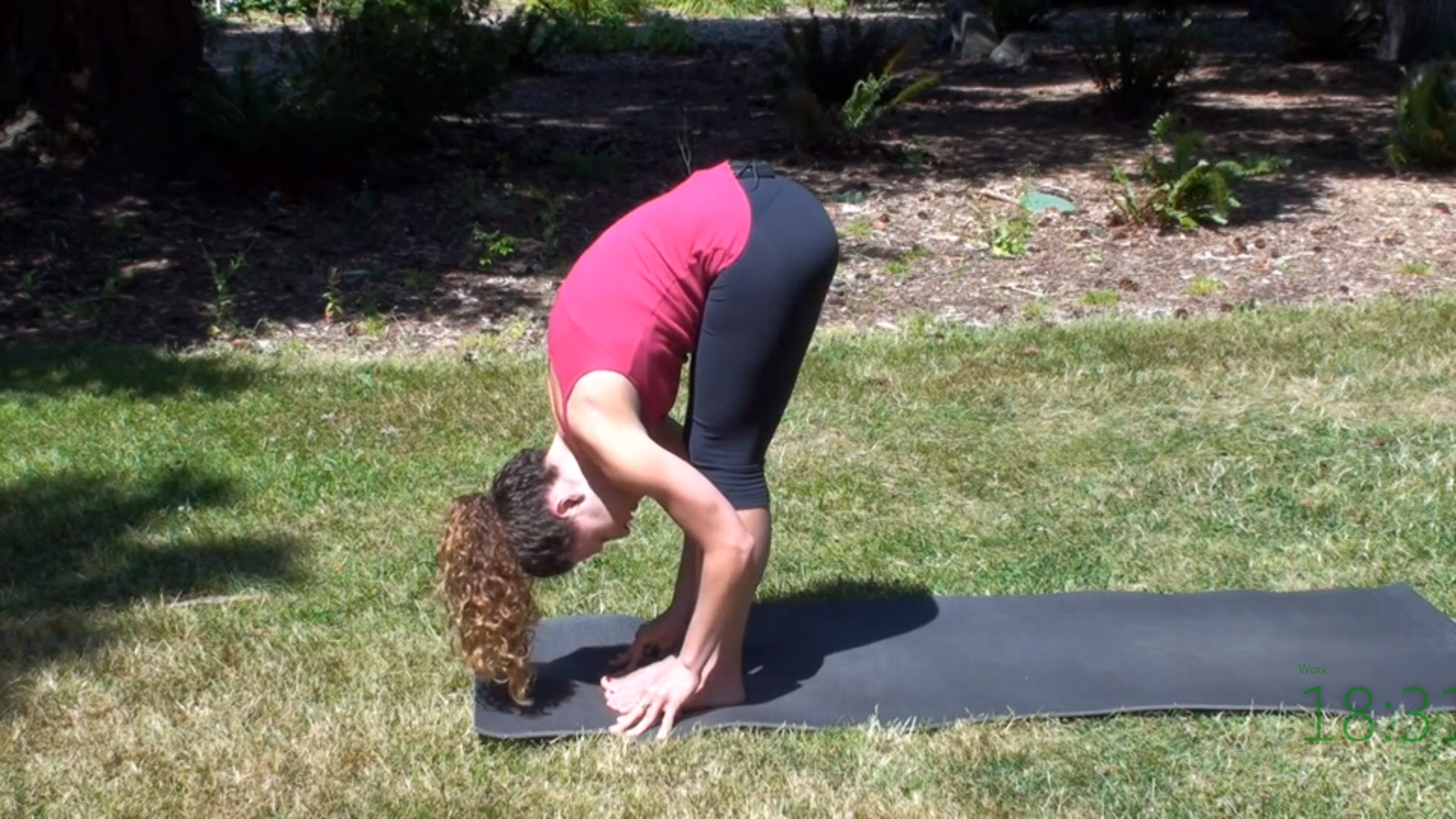
Many people hold tension in their necks. Uttanasana or standing forward fold is excellent for releasing that tension.
How to Do Standing Forward Fold
With your feet about hips-width apart, fold your torso over your legs. Inhale and focus on lengthening your spine and letting your neck release.
Remember to come up slowly so you don’t get light-headed; the aim is to sleep, not pass out.
Corpse Pose
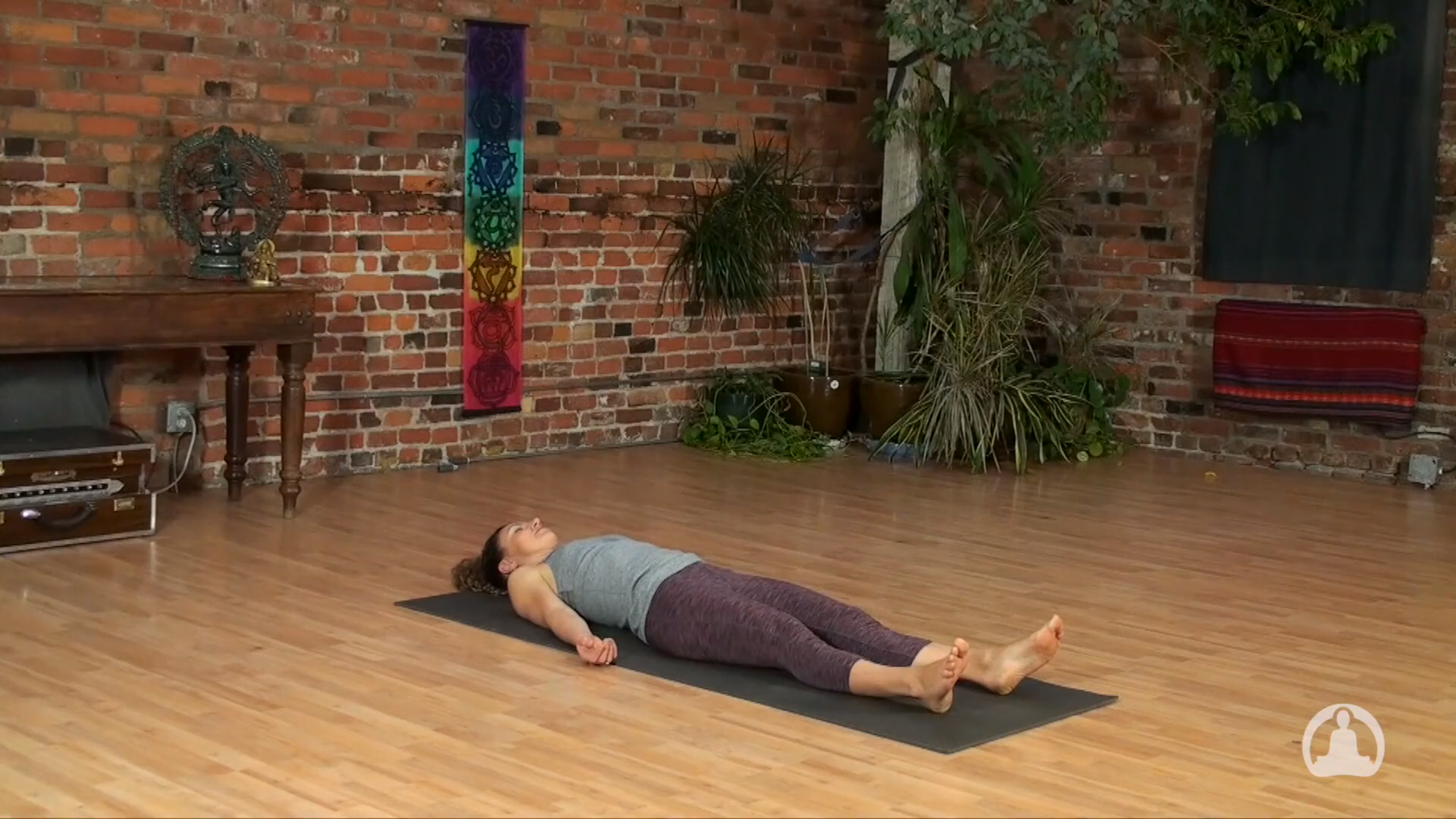
Yeah. It would be, wouldn’t it? Corpse pose or savasana, familiar as a final relaxation posture during a yoga session, might be the ultimate sleep pose.
How to Do Corpse Pose
Lying on your back on your mat, separate your legs and allow them to relax.
Move your arms away from your body, palms up, relaxed.
Soften every part of your body. Let it feel heavy.
Corpse pose may be most profound when you give it time, say five or ten minutes. Or, if you fall asleep, seven to nine hours.
Restorative Yoga Poses
In Daytime Restorative Flow, Tianne Allan takes viewers through a series of calming, restorative poses. See how long she spends making sure you are comfortable with your bolster, blankets, and block? Tianne leaves plenty of space for you to feel the benefits of these restorative poses.
Note that you can substitute your blocks, sofa cushions, or other household objects for bolsters and blankets as long as they help you stay comfortable.
The restorative poses in this sleep-encouraging video include:
Mountain Brook Pose
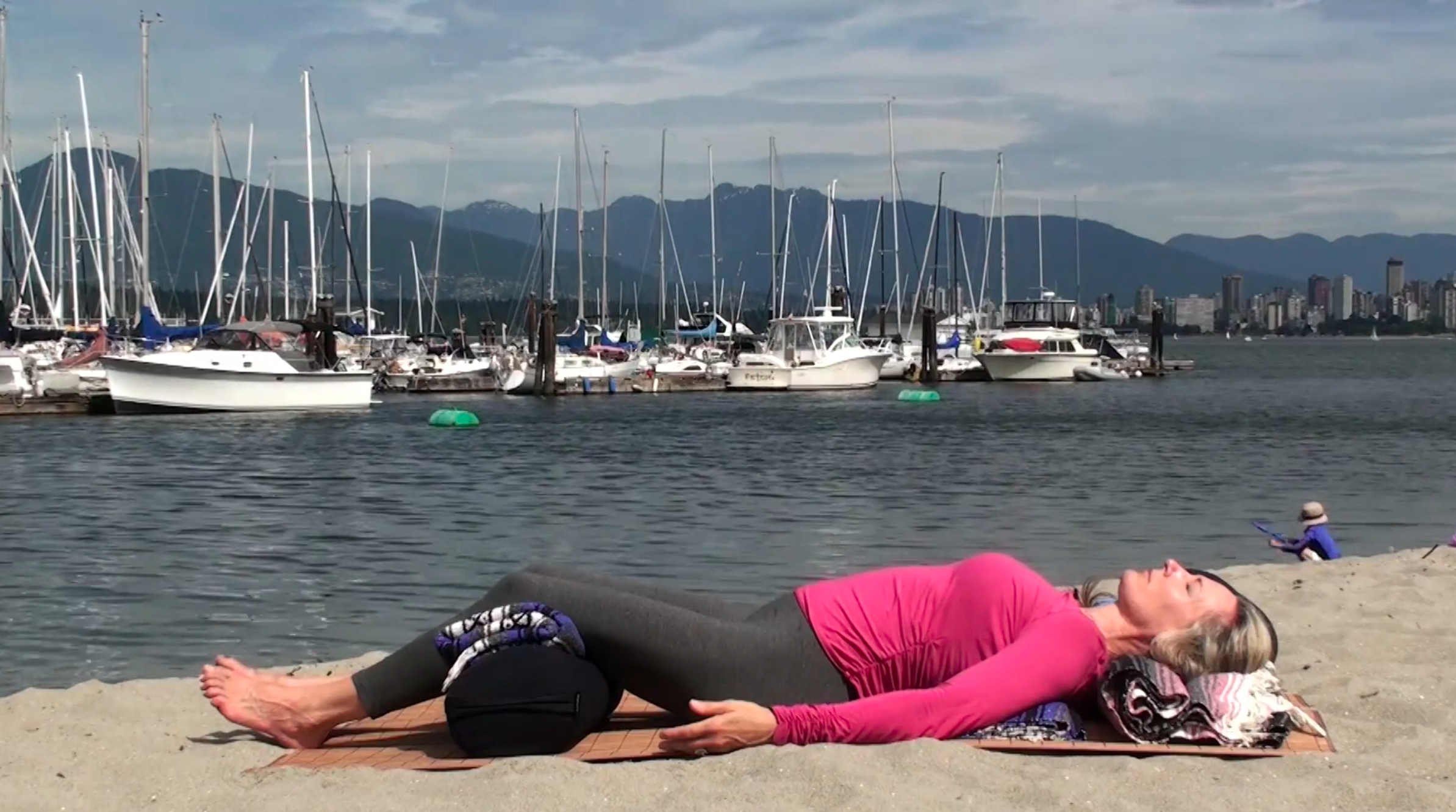
Mountain brook releases the lower back and expands the chest. Feeling your breath in this pose can take you right to sleep.
How to Do Mountain Brook Pose
Lie gently on your back with a bolster, cushion, or other support under your knees. Use a blanket under your rib cage and a second blanket curled up to support your cervical area. You can also add something soft below your head and neck.
Make adjustments as necessary and lie with your palms up.
Breathe into your belly.
For best results, listen to Tianne’s voice!
Reclining Cobbler’s Pose
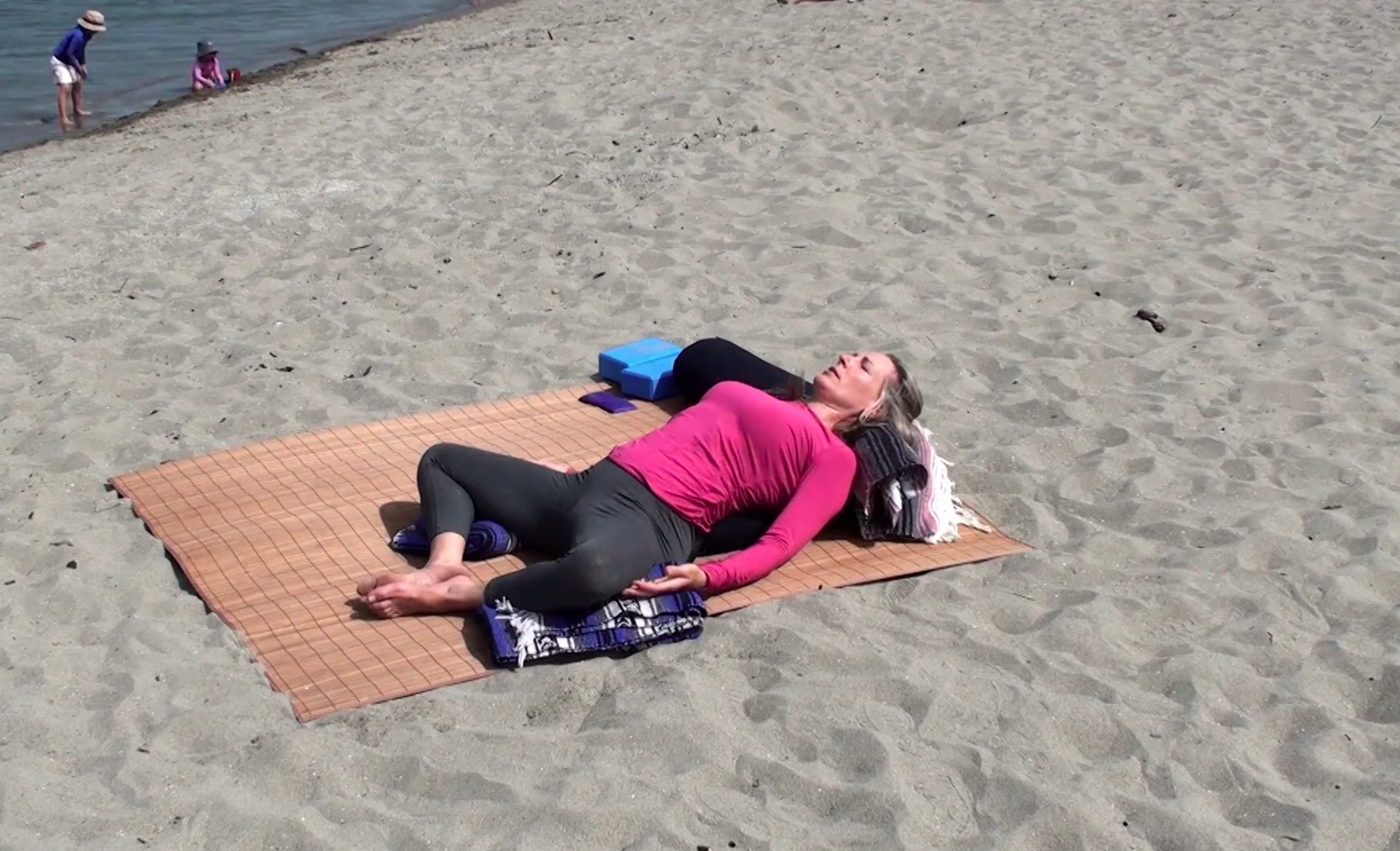
This pose gives you a lovely release rather than an active stretch. You’ll feel a nice opening through the hips and an expansion of your chest.
How to Do Reclining Cobbler’s Pose
A bolster at your tailbone provides support for this reclining pose. A folded blanket at the top of the bolster will support your head.
Put the soles of your feet together if possible and place a support prop beneath each knee.
Root through the hands to lengthen the torso and then lie back onto the bolster.
Take your time to find comfort in your body.
Let your hands rest on the blanket, your thighs, or put them up higher if that’s more comfortable for you.
Feel your breath.
Supine Twist
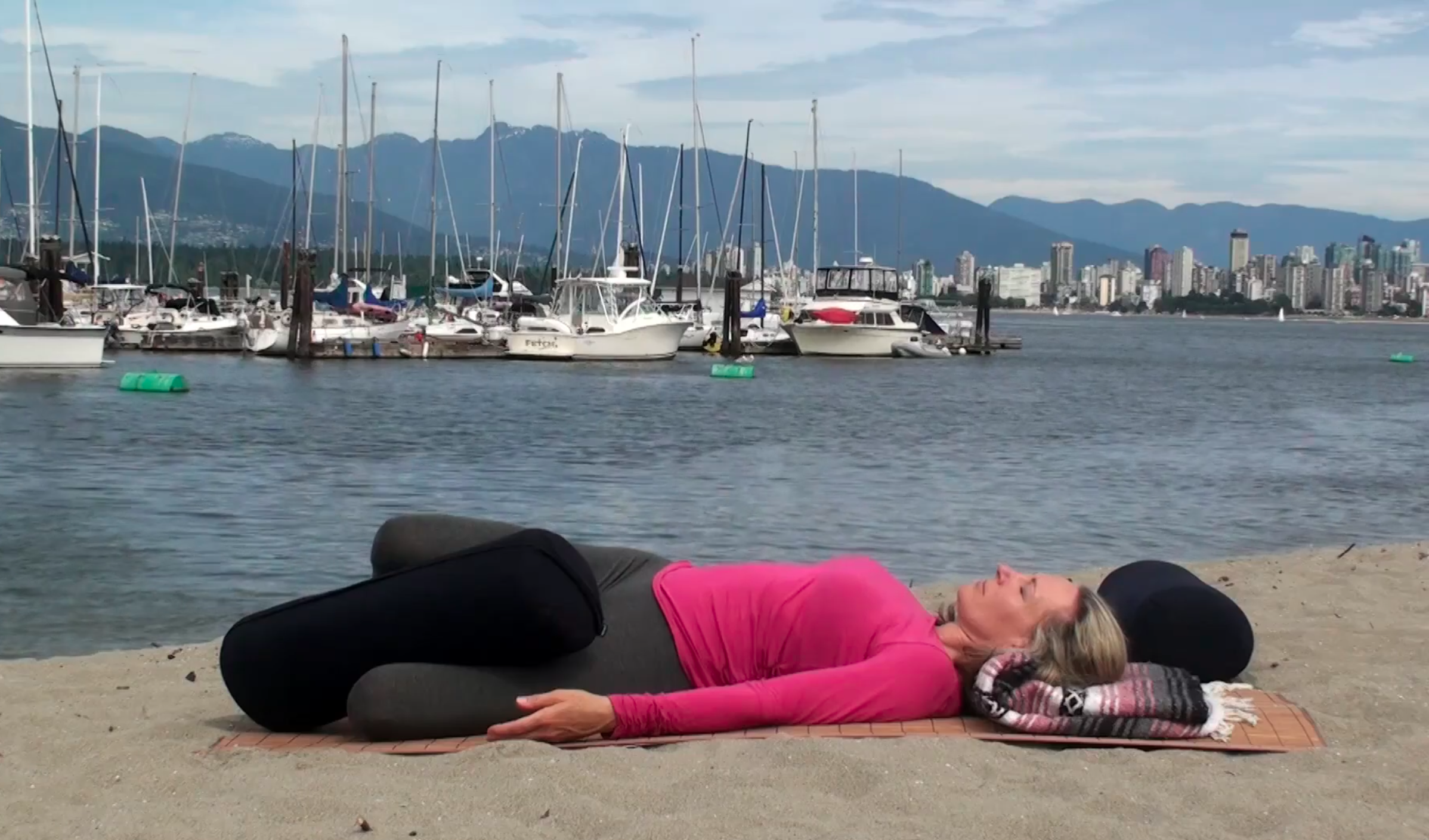
Cleanse and detoxify with supine twists. They activate the nervous system and will help you get your body ready for rest.
How to Do a Supine Twist
(Optional) Use a curled blanket or other support under your cervical area. Lower yourself onto your elbows and then onto your back.
Bend your knees at about a 90-degree angle and gently twist your lower body to one side. For comfort, you may wish to place a support such as a bolster between your knees.
You can spread your arms to the sides and turn your gaze in the direction opposite to the one you’ve turned your knees.
Adjust as necessary so long as it feels good. Feel the twist in your lower back, aiming to keep your navel above your spine as far as is comfortable. You may hear a nice, gentle crack!
When you are ready, gently draw the knees up to center and twist to the other side. You may want to adjust your supports when you are twisting in this direction.
Yogic Breathing for Better Sleep
Sleep advisers often refer to the 4-7-8 method to get a better night’s sleep. This technique is based on pranayama techniques, which utilize deep breathing, regularity, and focus to promote profound relaxation and readiness for sleep.
Yogic breathing, or pranayama, is excellent for calming the mind and relaxing the body. Whether you are breathing with movement or focusing on your breath while sitting or lying, incorporating pranayama into your daily routine can set the stage for sleep.
Yoga Nidra for a Peaceful Night
Meditation is a key component of yoga that’s going to help you get to sleep fast. Quieting the mind and raising your awareness is integral to yogic philosophy and practice.
Yoga nidra is a kind of guided meditation that is deeply relaxing, making it ideal for anyone who’d like to improve their sleep—or the sleep of their loved ones.
I’m writing this very early in the morning because my kid isn’t feeling well and couldn’t sleep. My wife made a doctor's appointment for the morning and I organized the yoga nidra.
Guess who managed to get back to sleep?
Yeah, all of us.
Yoga nidra is a gentle and pleasurable guided meditation that can take you on a journey around your body before sending you off to dream.
How DoYogaWithMe Can Help Your Sleep
One of the most coveted and elusive comforts in the “modern” world is sleep. That’s why we’ve created various yoga asana classes and nidra meditations to help you get through all the intrusive thoughts and anxious energy keeping you awake, and out the other end: the golden gates of Sleepytown.

DoYogaWithMe Yoga Classes for Sleep
These classes are for people who do want to sleep better but don’t necessarily want to lie on the mat the whole time. They’re active yet gentle classes, helping you ease the body and mind in preparation for sleep.
Hatha Yoga for Better Sleep
If you have insomnia or sometimes find it difficult to get to sleep, Melissa’s considerate, guided hatha yoga sleep class will help relax your body and settle your mind. And by the way—this class is free.
You’ll need 40 minutes (unless you fall asleep during the class) and a bolster (like a long, firm pillow). David has made a 90-second video on how to make your own bolster at home.
Micropractice: 10 Minutes to Prepare for Sleep
In this premium class, Rachel will guide you through a flow that could make a useful addition to your end-of-day routine.
Bedtime Yin Yoga
This class with Sarah-Jane includes long holds that are perfect for helping you wind down, fall asleep more quickly, and sleep more deeply. Say yes to her suggestion of a blanket and pillows to enhance your comfort.
Daytime Restorative Yoga
As outlined earlier, Tianne’s Daytime Restorative Yoga class will take you through a series of relaxing, calming poses. With her gentle guidance and plenty of ideas for supporting your body throughout, these poses will help you let go and make your journey toward sleep.
Rest and Recover: Spaciousness
Tianne guides you through a restorative practice you can do on your mat or in your bed. Listen to her calming voice as she takes your body through a gentle flow that opens you up, culminating in a long, deep relaxation.
DoYogaWithMe Yoga Nidra Meditations
Deep Rest: Restorative and Yoga Nidra Meditation
All levels are welcome to use this powerful 20-minute yoga nidra practice led by Tianne. Simply listen and receive.
Yoga Nidra for Sleep
This yoga nidra sleep meditation is the one that got my kid to sleep. I’ve rewritten the existing blurb on Jennifer’s guided meditation to explain:
“Her deeply calming voice penetrates into your CHILD’s very soul, instilling a sense of internal peace and leaving your CHILD feeling incredibly relaxed, present, and rejuvenated.”
Also works for adults, of course. Her voice is soothing.
Yoga Nidra: Sleep Sessions
If you can’t get enough of Yoga Nidra for Sleep, here’s another meditation with Jennifer as your guide. This contains not one but five meditations.
When you wake up, leave a comment to let us know how great it was.
Drift Off With DoYogaWithMe

Throw your smartphone into a blender and turn it up to MAX. Avoid coffee, sugary drinks and food, alcohol, and large meals before bed. Keep your room dark and try to only use it for sleeping.
That’s good sleep hygiene.
At the same time, yoga can support your good practices and help you get some rest. Give yourself the best possible chance of a lovely, peaceful, flying-dream-filled night by doing yoga classes and yoga nidra meditations for sleep.
Don’t worry—you can do yoga to wake yourself up in the morning, too.



Comments
Existing Comments